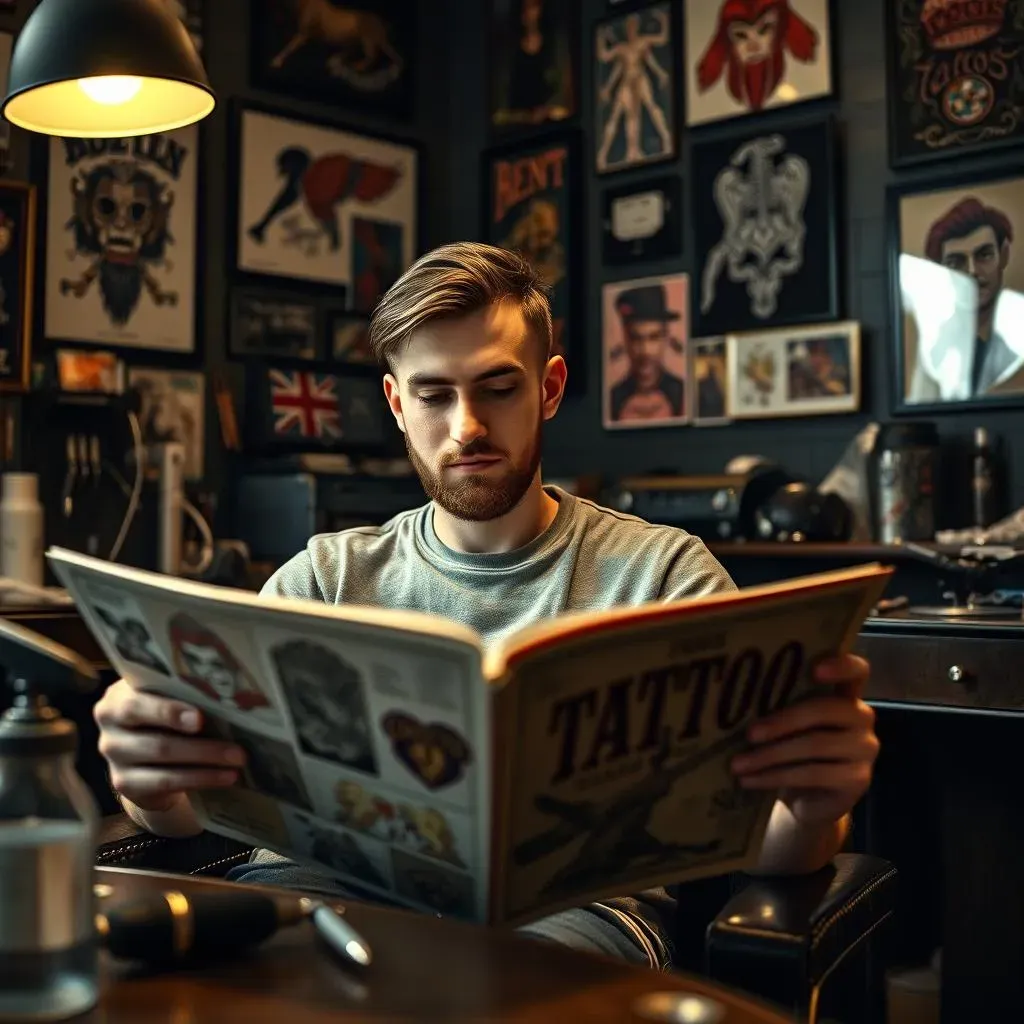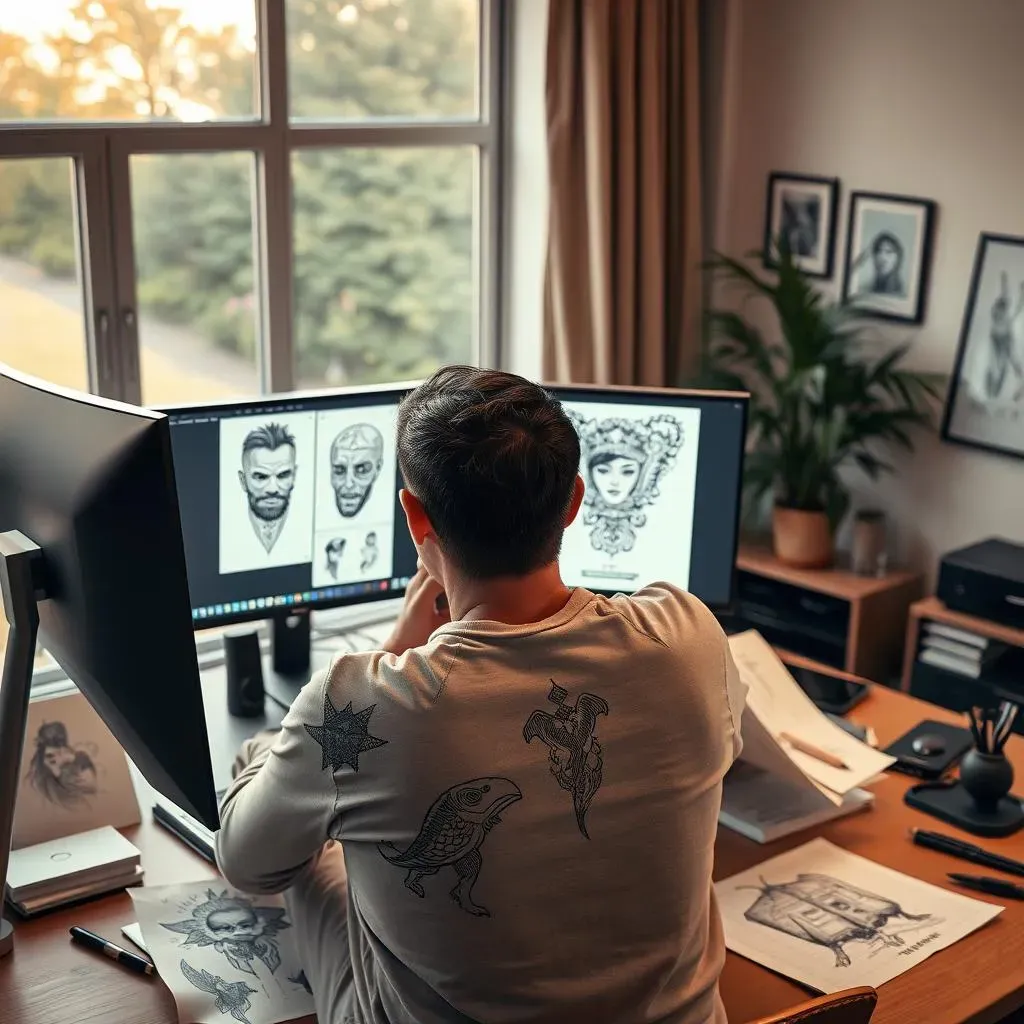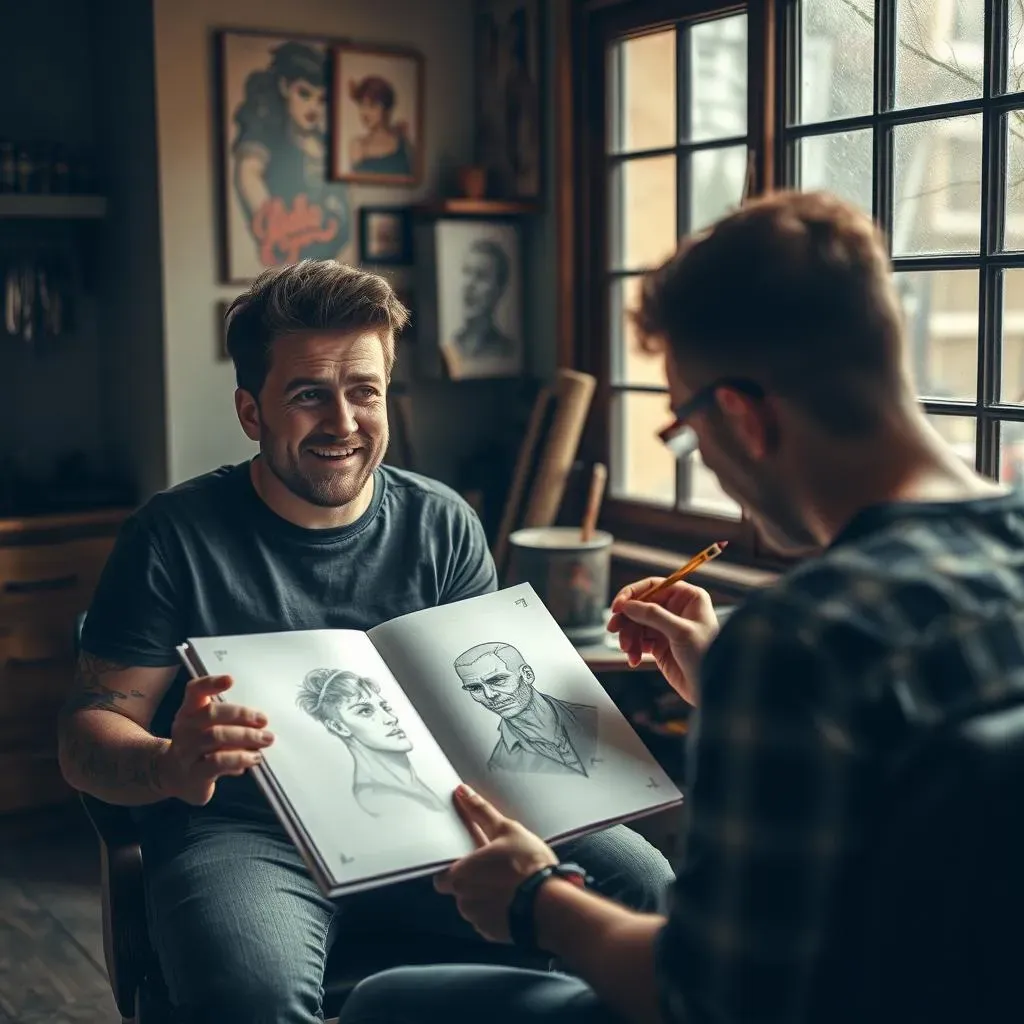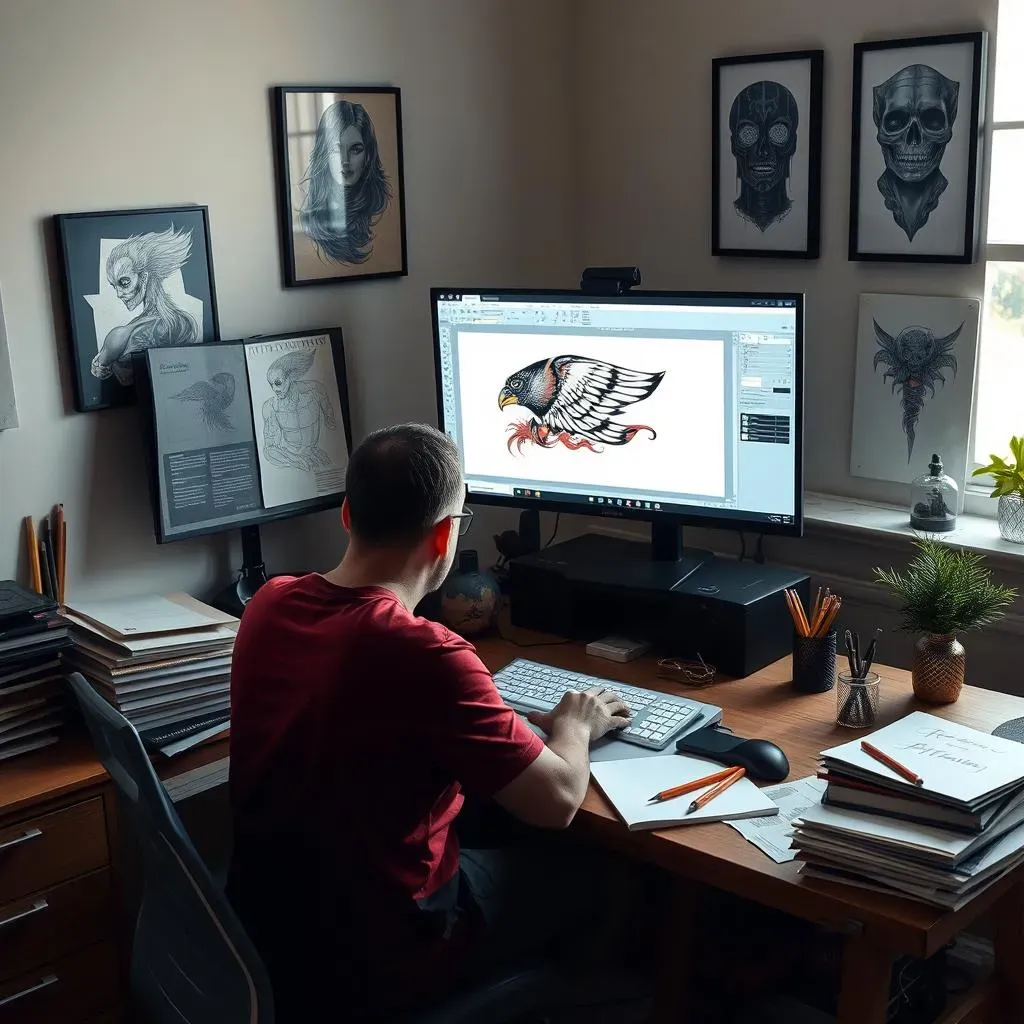Table of Contents
So, you're itching for some new ink, but you need a design first? You're probably wondering, "Where to get a tattoo designed?" You're not alone. Finding the perfect artist or platform to translate your vision into a stunning tattoo can feel overwhelming. This guide cuts through the noise, giving you the lowdown on everything from scouting local talent to harnessing the power of online design services. We'll explore the pros and cons of each approach, offering practical tips to ensure your custom tattoo design is everything you've dreamed of. Whether you're a seasoned collector or a first-timer, get ready to discover where to find the resources and expertise needed to bring your unique tattoo idea to life. Let's dive in and turn that dream into reality, one needle prick at a time.
Finding the Right Tattoo Artist for Your Design
Finding the Right Tattoo Artist for Your Design
#1: Portfolio Peeping: Your First Line of Defense
Think of a tattoo artist's portfolio as their resume – it's where they showcase their best work and highlight their specific skills. Don't just glance; really study it. Are the lines crisp and clean? Is the shading smooth and consistent? Does their style align with the vision you have for your tattoo? If you're after a traditional American piece, an artist specializing in watercolor might not be the best fit. Instagram is your friend here! Most artists actively update their pages with recent work. Look beyond the finished product, too. Do they post healed photos? This shows how their tattoos hold up over time, which is super important.
Pay attention to the details. Are the colors vibrant and long-lasting? Is the linework consistent, or does it appear shaky in places? Different artists excel in different styles. Some are masters of realism, creating stunningly lifelike portraits. Others are drawn to the bold lines and bright colors of traditional tattoos. Some might do black and gray while others are more diverse. Matching your design to an artist's strengths is key to a great tattoo.
#2: Consultation is Key: Vibe Check Time
Once you've narrowed down a few potential artists based on their portfolios, schedule consultations. This is your chance to discuss your ideas in detail, ask questions, and get a feel for their personality. A good artist will listen attentively, offer suggestions, and be transparent about their process and pricing. If an artist seems dismissive, uninterested, or unwilling to collaborate, that's a major red flag. Your comfort level is paramount. You're trusting this person to permanently alter your body, so you need to feel confident in their abilities and comfortable in their presence.
During the consultation, bring reference images, sketches, or anything else that helps illustrate your vision. Be open to the artist's input, but don't be afraid to voice your own preferences. A collaborative approach usually yields the best results. Also, don't be shy about discussing practical matters like aftercare, touch-up policies, and payment options. Getting all the details ironed out upfront will prevent misunderstandings down the road.
#3: Shop Around (Literally): Environment Matters
Don't underestimate the importance of the tattoo shop environment. Is it clean and well-maintained? Does it feel professional and welcoming? A reputable shop will adhere to strict hygiene standards, using sterile equipment and disposable needles. Don't hesitate to ask about their sterilization procedures. Your health and safety are non-negotiable. Observe how the artists interact with their clients. Do they seem friendly and approachable, or are they aloof and intimidating? A positive and supportive atmosphere can make the whole experience much more enjoyable.
Consider the shop's overall vibe. Does it reflect your personal style? Some shops cater to a specific clientele or aesthetic, while others are more diverse. Find a place where you feel comfortable and inspired. After all, getting a tattoo should be a positive and memorable experience, not a stressful or unpleasant one. Also, take the time to read online reviews and testimonials. See what other clients have to say about their experiences with the shop and its artists. This can provide valuable insights into the quality of their work and their customer service.
Hygiene Checklist:
- Autoclave sterilization
- Single-use needles
- Gloves worn at all times
- Clean workstation
- Proper disposal of sharps
Online Platforms for Custom Tattoo Designs
Online Platforms for Custom Tattoo Designs
Alright, so maybe hitting up a local artist isn't your jam, or you just haven't found the right fit yet. No sweat! The digital world is overflowing with online platforms for custom tattoo designs, connecting you with artists from all corners of the globe. These platforms offer a convenient way to browse portfolios, commission custom artwork, and collaborate with designers remotely. Think of it like online dating for your skin – swipe right on the perfect design!
But, like anything online, it pays to be a savvy shopper. Not all platforms are created equal, and the quality of work can vary wildly. Let's break down some of the key players and what to look for to ensure you're getting a killer design without getting scammed.
#1: Diving into the Digital Tattoo Pool
Several websites specialize in connecting clients with tattoo designers. Sites like Fiverr, Upwork, and Tattoodo host a vast array of artists with different styles and price points. These platforms let you browse portfolios, read reviews, and communicate directly with designers. Some platforms even offer contests where multiple artists submit designs based on your brief, giving you a wide range of options to choose from.
However, the sheer volume of options can be overwhelming. It's crucial to carefully vet each artist, paying close attention to their portfolio, client reviews, and communication style. Don't be afraid to ask for additional samples of their work or request a preliminary sketch before committing to a full design.
#2: Weighing the Pros and Cons
Pros:
- Global Talent Pool: Access artists worldwide, expanding your stylistic options.
- Competitive Pricing: Often more affordable than traditional tattoo artists.
- Convenience: Design collaboration from the comfort of your couch.
- Design Variety: Platforms offer diverse styles and design approaches.
Cons:
- Quality Control: Inconsistent skill levels among artists.
- Communication Barriers: Language differences or slow response times.
- Potential Scams: Risk of receiving subpar or plagiarized designs.
- Lack of Personal Connection: Missing the in-person consultation experience.
#3: Red Flags to Watch Out For
Before handing over your hard-earned cash, keep an eye out for these warning signs:
- Generic Portfolios: Images that look like they were pulled from Google Images.
- Unrealistic Pricing: Deals that seem too good to be true usually are.
- Pushy Sales Tactics: Artists who pressure you to commit without a consultation.
- Poor Communication: Vague answers, grammatical errors, or slow response times.
Trust your gut. If something feels off, it's better to err on the side of caution and move on to another artist. Remember, this is going on your body forever, so due diligence is key.
Commissioning a Tattoo Design: What to Expect
Commissioning a Tattoo Design: What to Expect
#1: Setting the Stage: Initial Consultation and Brief
So, you've found an artist whose style speaks to you – awesome! Now comes the crucial step of commissioning a tattoo design. This usually starts with an in-depth consultation. Think of it as a brainstorming session where you and the artist hash out every detail of your vision. Be prepared to articulate your ideas clearly and provide as much reference material as possible. This isn't just about showing them what you want; it's about helping them understand why you want it. What's the story behind the tattoo? What emotions or memories do you want it to evoke?
The artist will likely ask about placement, size, color preferences, and any existing tattoos you might have. Don't be afraid to ask questions too! This is your chance to get a feel for their creative process and ensure they're on the same page as you. A good artist will listen attentively, offer suggestions, and be transparent about their pricing and timeline. They'll also create a brief – a written summary of your discussion – to ensure everyone is aligned before moving forward. This brief serves as a roadmap for the design process, minimizing the risk of miscommunication and ensuring you get exactly what you're looking for.
Key Questions to Ask During the Consultation:
- What is your hourly rate or flat fee for design work?
- How many revisions are included in the price?
- What is your preferred method of communication?
- What is the estimated turnaround time for the design?
- What is your policy on deposits and refunds?
#2: The Design Process: From Sketch to Stencil
Once the brief is finalized, the artist will start working on the design. This usually involves creating a series of sketches or digital mock-ups, which they'll share with you for feedback. This is where the collaborative process really shines. Be honest and constructive with your feedback, but also be open to the artist's suggestions. Remember, they're the experts, and they might have ideas that you haven't considered. It's totally normal to request revisions at this stage. Most artists include a certain number of revisions in their initial price, but be mindful of their time and avoid making excessive or unreasonable requests.
As the design progresses, the artist will refine the details and create a final stencil. This stencil is essentially a roadmap that will be transferred onto your skin before the tattooing begins. Take your time to review the stencil carefully and ensure you're completely happy with it. Once the needle hits your skin, there's no going back! If you have any doubts or concerns, speak up now. A good artist will be patient and understanding, and they'll work with you to address any issues before proceeding.
Stage | Description | Your Role |
|---|---|---|
Sketching | Artist creates initial concepts. | Provide clear and honest feedback. |
Revisions | Adjustments based on your feedback. | Be specific and reasonable with requests. |
Stenciling | Final design transferred to stencil. | Carefully review and approve the stencil. |
DIY Tattoo Design: Tools and Resources
DIY Tattoo Design: Tools and Resources
#1: Digital Design Software: Unleash Your Inner Artist
so you're feeling adventurous and want to take a crack at designing your own tattoo? Awesome! The digital age has made DIY tattoo design more accessible than ever. Several user-friendly software options cater to both beginners and experienced artists. Programs like Procreate (for iPad), Adobe Photoshop, and Inkscape (free!) offer a wide range of tools for creating stunning designs. Don't be intimidated if you're not a tech whiz. Many online tutorials and courses can help you master the basics and unlock your creative potential.
Think of these programs as your digital canvas. You can import reference images, experiment with different styles, and create intricate details with ease. Plus, digital design allows you to easily resize, recolor, and modify your artwork until it's absolutely perfect. Just remember to save your work frequently and in a high-resolution format to ensure it looks crisp and clear when it's finally inked onto your skin.
Software Options for DIY Tattoo Design
- Procreate: User-friendly, iPad-based app with a wide range of brushes and tools.
- Adobe Photoshop: Industry-standard software with advanced features and customization options.
- Inkscape: Free, open-source vector graphics editor ideal for creating scalable designs.
- Autodesk Sketchbook: Free app with a clean interface and intuitive drawing tools.
#2: Traditional Tools: Back to Basics
If you're more of a hands-on type of person, don't underestimate the power of traditional art supplies. Good old-fashioned pencils, paper, and erasers can be surprisingly effective for DIY tattoo design. Start by sketching out your ideas in rough form, experimenting with different shapes, sizes, and compositions. Once you're happy with the overall layout, you can refine the details and add shading to create a more polished look.
Consider using tracing paper to transfer your design onto your skin before getting inked. This allows you to get a feel for the placement and size of the tattoo and make any necessary adjustments. Remember, practice makes perfect! Don't be discouraged if your first few attempts don't look exactly as you imagined. Keep experimenting, keep learning, and most importantly, keep having fun!
"Creativity is contagious, pass it on." - Albert Einstein
Ensuring Your Tattoo Design is Perfect: A Checklist
Ensuring Your Tattoo Design is Perfect: A Checklist
Alright, you've put in the work, found an artist (or designed it yourself!), and now you're staring at what could be your next piece of body art. But hold up! Before you commit to that stencil, let's run through a final checklist to make absolutely sure your tattoo design is perfect. This isn't just about aesthetics; it's about longevity, clarity, and avoiding future regrets. Think of it as a pre-flight check before your ink takes off!
This stage is crucial. You want to be absolutely certain that the design is exactly what you want before it becomes a permanent part of you. Take your time, be meticulous, and don't be afraid to ask questions or request changes if something doesn't feel right. Remember, this is an investment in yourself, so it's worth taking the extra steps to ensure it's a worthwhile one.
#1: The Clarity Check: Can You See What It Is?
This seems obvious, but it's easy to get caught up in the details and lose sight of the big picture. Step back and ask yourself: is the design easily recognizable? Are the lines clear and distinct? Will it still look good as it ages? Intricate designs with tiny details can blur over time, especially in areas where the skin stretches or rubs against clothing. Consider simplifying the design or increasing the size to ensure it remains legible for years to come. Black and grey tattoos tend to hold up better over time, but colored tattoos can fade or change hue.
Also, think about the placement of the tattoo. Will it be visible most of the time, or will it be hidden under clothing? This can influence the size and complexity of the design. A small, intricate tattoo on your ankle might look beautiful up close, but it could easily get lost from a distance. A larger, bolder design on your arm might make a bigger statement, but it could also be more prone to fading or distortion over time.
Clarity Considerations:
- Line thickness and spacing
- Size relative to placement
- Potential for blurring over time
- Color choices and their longevity
#2: The Meaning Check: Does It Still Resonate?
Tattoos are often deeply personal, reflecting our beliefs, values, and experiences. But tastes change, and what seems meaningful today might not hold the same significance tomorrow. Before you commit to a design, take some time to reflect on its meaning and significance. Does it represent something that is truly important to you? Is it something you'll be proud to wear for the rest of your life? Avoid trendy designs or fleeting interests that might lose their appeal over time. Opt for timeless symbols, meaningful quotes, or personal imagery that will continue to resonate with you for years to come. For example, think about getting the name of your significant other, are you sure they are the one? How about quotes from books, will you still be interested in that book in 10 years?
Also, consider the cultural context of your design. Certain symbols or images might have different meanings in different cultures, and you want to avoid unintentionally offending or disrespecting anyone. Do your research and make sure you understand the history and significance of your chosen design. A little bit of cultural sensitivity can go a long way in ensuring your tattoo is both meaningful and respectful.
#3: The Practicality Check: Will It Work on Your Skin?
Not all designs translate well onto skin. Factors like skin tone, elasticity, and the presence of scars or moles can affect the final outcome. Consult with your tattoo artist to ensure your chosen design is suitable for your skin type and placement. They might recommend adjustments to the size, color, or linework to optimize the design for your specific needs. For example, lighter skin tones tend to show colors more vividly, while darker skin tones might require bolder linework to ensure the design stands out.
Also, be aware of any allergies or sensitivities you might have to certain inks. Some people are allergic to certain pigments, particularly red and yellow. If you have sensitive skin, ask your artist to use hypoallergenic inks or to do a patch test before starting the tattoo. A little bit of precaution can prevent a lot of discomfort and potential complications down the road.
Factor | Considerations |
|---|---|
Skin Tone | Color visibility, linework boldness |
Elasticity | Potential for distortion over time |
Scars/Moles | Design placement and integration |
Allergies | Ink selection and patch testing |
The Final Word on Getting Your Tattoo Designed
Ultimately, the best place to get your tattoo designed depends on your individual needs, budget, and artistic preferences. Whether you opt for a local artist, an online platform, or even try your hand at DIY design, remember that communication and collaboration are key. Take the time to research your options, clearly articulate your vision, and don't be afraid to ask questions. With the right approach, you can ensure that your new tattoo is not only a beautiful work of art but also a meaningful expression of your personal story. Now go forth and get inked!